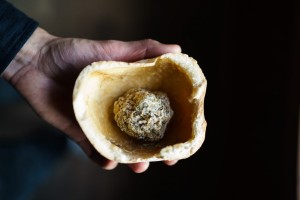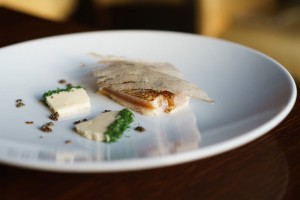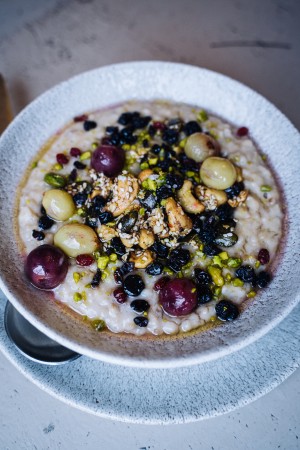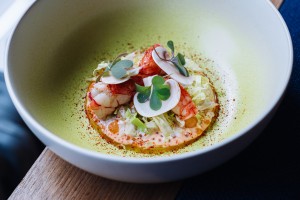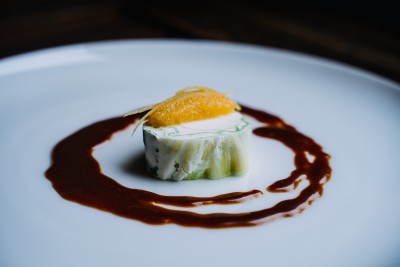Germans have always had a deep and profound relationship with Austrians when it comes to their food. Not many will happily admit to this, but a lot of German food culture is either directly or indirectly based on Austrian cuisine. Visit any, random German restaurant across the republic and you are likely find a Schnitzel and Kaiserschmarrn on the menu.
If you consider this, it actually seems quite natural that one of Berlin’s finest restaurants is run by an Austrian. The establishment I’m referring to goes by the name of Horváth (named after the Austrian-Hungarian novelist), a restaurant that’s existed since 2008 but where a change of ownership in 2012 morphed this bastion of Austrian food culture into a temple of true gastronomic excellence. The new owners were Sebastian Frank and Jeannine Kessler and as a team (Sebastian in the kitchen and Jeannine in management), this utterly humble couple have in five years convinced pretty much everyone of the excellence of their restaurant Horváth. 18 Gault Millau points, 2 Michelin stars, Berliner Meisterkoch 2017, Berlin’s 50 Top Restaurants 2016 & 2017 - the list of Horváth’s accolades reads long and after a recent visit that left no senses untouched, it became clear to me that the time has come for me to join this choir in the front row.
“ "Not many will happily admit to this, but a lot of German food culture is either directly or indirectly based on Austrian cuisine."
Horváth is located on the prime restaurant strip of Paul Lincke Ufer on the Northern shore of the Landwehr canal that crosses through the Kreuzberg and Neukölln districts. The initial visual appearance would probably not strike you as a restaurant with two stars - the small size, the outdoor terrace, the wooden wall panels; all items you would expect to find in a Gaststube and not a groundbreaking, fine dining restaurant. Yet here you you’ll find Sebastian Frank, the smiling Austrian who has made this ancient house his personal temple of culinary development.
“ "The initial visual appearance would probably not strike you as a restaurant with two stars."
The core foundation of Frank’s cuisine is his education as a chef in Austria where he worked his way through “thousands of Knödel and Strudel”. as an apprentice. He spent some time in the kitchen of great restaurants (among others the “old” Steiereck), but he essentially sees himself as self-taught chef. This because his position as head chef at Horváth came as a sudden opportunity at a young age when he moved back to Berlin with his family. Suddenly he was in charge of a restaurant with ambitions, not really knowing what to cook, resulting in a wild mix up of Austrian cuisine with luxury ingredients like lobster and horse mackerel. After six months he made the cut towards local ingredients to maximize quality and he never looked back.
“ "After six months he made the cut towards local ingredients to maximize quality and he never looked back."
This wasn’t the last time the kitchen changed, in the course of the following eight years the food concept at Horváth shed it’s skin multiple times. Frank was determined to move his cuisine forward, even if that meant losing regulars who weren’t willing to follow him on this journey. It turned out his ambition was well placed and the lost regulars were replaced by new ones. The first star came in 2011, the second in 2015 and with it an artistic freedom that gave him the confidence to pursue his vision of a contemporary Austrian cuisine rooted in ingredients from the greater Berlin area.
The result we see today, a triumphing menu that’s been put through countless filters and captures your senses from the first plate to the last glass. The food is spectacular, but the beverages deserve more than a side note. On one hand you have a wine cellar that features an unique and highly interesting selection of bottles from the “Kaiserlich-Königlich” region of the former Austrian-Hungarian empire, and on the other side you have a non-alcoholic juice pairing that’s unbelievably impressive. Think "Whey with horseradish, honey and camelina oil" or "Radicchio water with almond-lemon oil". This is quite frankly the best juice pairing I’ve encountered in Germany, not only utterly forward-thinking, but most importantly stunningly well paired with the food.
“ "The result we see today, a triumphing menu that’s been put through countless filters and captures your senses from the first plate to the last glass."
A meal at Horváth always starts with a cup of aspic made according to an ancient 1894 recipe - a savoury, slightly acidic and flavour-packed meat consommé served hot in the winter and cold in the summer. The dishes that follow are a journey into Austrian comfort flavours with complex side stories that surprise you over and over. Like the famous crowdpleaser “Trout and chocolate”, a dish where a pristine piece of trout is lightly cured and flamed with a bit of lard, topped with a crunchy veal head wafer and then served with iced, white chocolate and roasted mustard seeds. A highly unorthodox combination that however makes all the sense in the world when you try the savoury chocolate fuelled by vinegar and dill.
A plate that’s emerged as one of Frank’s signature dishes is the “Celery Ripe and Young”, a cunning take on a peasant ingredient such as celeriac root where steamed, thin slices of the root vegetable are dressed in a chicken bouillon and then served with generous shaving of no, not truffle, but a dried celeriac root. That’s right, a celeriac root that’s been salt-baked and then aged in the salt shell for 12 months, a process that produces a umami-packed bombshell that complements the young celeriac extraordinary well.
“ "A highly unorthodox combination that however makes all the sense in the world when you try the savoury chocolate fuelled by vinegar and dill."
In terms of visual presentation the dishes at Horváth have developed tremendously, such as the striking yellow beet with smoked lard glaze and roasted poppy seeds or the marzipan pumpkin dessert where half the plate is dusted with a pitch black vegetable powder. Damn beautiful plates but, most importantly also damn delicious. Frank has become a master at at marrying ingredients in ways that you wouldn’t expect to work and this practice extends all the way to the last petits fours, a brilliant blood chocolate praline with brown butter that will redefine any concept you have on using blood in a dessert.
“ "Sebastian Frank has leaped onto a new level of excellence and confidence this year and is righteously celebrated as one of the best chefs in Berlin."
I visited Horváth in the spring and in the fall and what during the first encounter was a good meal with a couple of dishes that didn't convince fully, was in the fall a home-run out of the ballpark that convinced across all levels. Sebastian Frank has leaped onto a new level of excellence and confidence this year and is righteously celebrated as one of the best chefs in Berlin. Quite remarkable considering he’s working out of a house that dates back to the 1850’s. The venue might have a lot of charm, but it’s also slightly outdated and it is tangible how Frank’s ambitions have outgrown this location. Frank is one of the best representatives of Berlin on the global food scene and his food is without a doubt some of the most interesting and best fine dining you can have in Berlin right now. With a venue and kitchen to match his ambitions, the sky is the limit for him and his disciples.
